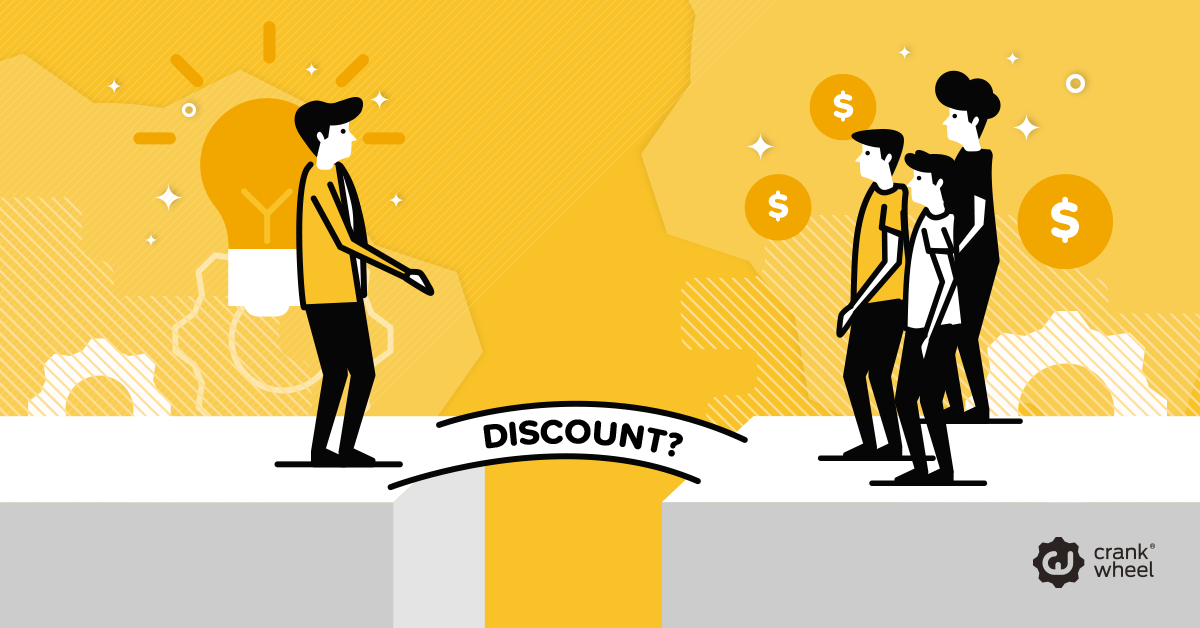When a prospect responds yes, but only if they get a discount
“Are you ready to go ahead?” Whatever way you bring a successful sales negotiation to a close, one of the most frustrating things a prospect can say is, “Yes, but . . .” and then they ask for a discount.

Often, when that happens, it means the are only saying yes contingent on getting that discount. No matter how good a job you’ve done of selling the benefits, price is clearly a more important consideration than maybe they’ve mentioned until now.
When should you offer discounts?
Discounts are a great way of moving a slow negotiation forward.
Discounts are useful when you want to create good-will with a long-term, strategic and valuable client.
Discounts and creating scarcity are a great way of breaking into a new market or sector/vertical. You might strategically offer discounts to some big names in a new sector or country, but reap the benefits with new clients after a select group buy-in at the discount rate.
In short, discounts are only useful when you’ve more to gain than the impact of a margin reduction on a particular deal. Apply them strategically. Use them wisely.
Downsides of discounting
Apart from the scenarios mentioned above, discounting too heavily and too often has numerous downsides.
- Margin attrition, especially in B2B sales — in what is known as the ‘last mile of pricing’ — erodes margins and therefore profitability;
- In the rush to hit sales goals and revenue goals, sales teams can cause long-term damage to a company’s profitability, so although targets may be hit, these wins come at a cost.
- Buyers see what you are offering as less valuable. If you’ve been talking about an ROI, why so eager to discount and sell it for a lower rate?
- When it comes to recommendations, buyers — new clients — will tell others how cheap you are; not necessarily one of the brand values you want out in the world when growing.
- A discount shifts focus from value to price. When conversations are value-driven, the seller has more power. When this moves to price-driven, it comes down to a tug of war that buyers rarely win.
- Sellers lose power. Negotiation is about give-and-take. Offering a discount too readily, and giving away too much, weakens the provider in any client relationship, getting things off on the wrong foot. Weakening a new commercial relationship in the early-days is potentially a bad sign of how it could evolve.
For these and other reasons, unless there is a sensible commercial and strategic reason for offering a discount, they should be avoided at all costs.
How to respond to, “How much discount can we have?”
#1: During discovery calls/meetings or online demos
Something you might have come across before. On the first call or in the first meeting, a potential client asks for a discount. Not a great start. How do you respond?
“I’m the right person to ask about this, but first, let’s look at what you really need. This way, I can give you an accurate price for our services.”
When a price is tailored, not off-the-shelf, you can more easily determine a rate that keeps a prospect happy and sticks with the margins you need.
#2: When they raise the issue as soon as prices are mentioned
“That is a good question; is price a potential obstacle that would prevent you going ahead?”
Pretty important one, this.
Does a prospect you are talking to have a budget?
What purchasing power do they have themselves? At what point would they need someone more senior to approve/sign-off a suitable budget?
At the end of the day, can they afford what you are selling or not?
If price is a real roadblock, and you can’t discount in this case, or can’t offer the sort of discount they need, then walking away might be the only option. Price is always going to play an important role in every commercial negotiation. So, when this question is raised early into a conversation about services and prices, it’s a good indication that they’re maybe more price sensitive than others.
On the other hand, they might have the budget, but are just seeing what kind of discount they can get. These are prospects whereby a strategic discount to start with could pay long-term dividends down the road, when you offer to up-sell them additional products or services.
#3: Give them a discount, in exchange for . . .
“Yes we can do that, but are you willing to sign a 24 instead of a 12-month contract? Then we can review the service we are providing and appropriate prices at that point.”
This is where give and take plays a key role in the value exchange.
If a lower price is important to them, then gain something valuable in exchange. Such as, longer contract terms, a testimonial, a referral, or something else that will strategically benefit your company.
#4: Ask them what they consider a reasonable discount is?
It could be that they don’t think $100,000 is reasonable for what you are offering. Or they have an incumbent willing to discount to keep them as a customer. Or they’ve been offered lower rates for similar solutions by competitors.
Whatever reason, a prospect asking for a discount either can’t afford the full price, despite wanting to go ahead, or only sees a specific value in the service you are providing.
As long as a prospect negotiates in good faith, and you ask them the right questions, you should be able to navigate the complexities of discount negotiations and get a deal that satisfies both parties. If in doubt, or if there is no budget, then walk away and save yourself time. Focus on prospects that have the budget and won’t waste your time.
